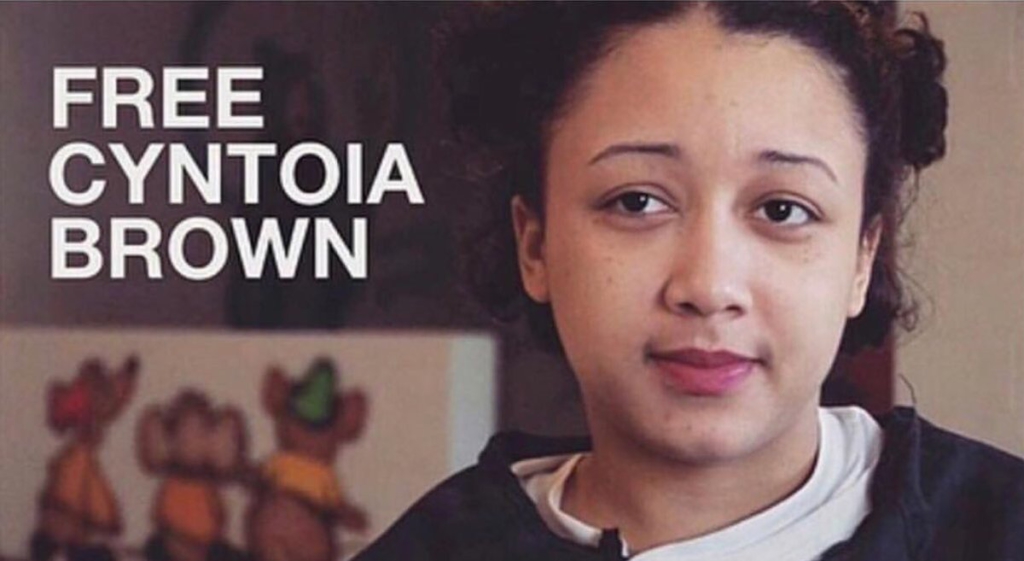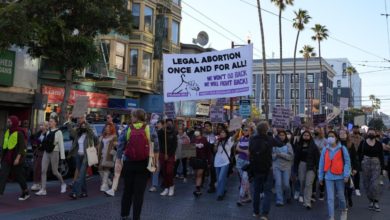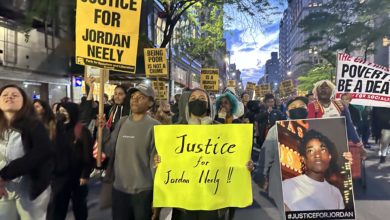
UPDATE: Due to mass pressure, on Jan. 5, Tennessee Governor Bill Haslam granted clemency to Cyntoia Brown, commuting her life sentence. She will be released on Aug. 7, but must spent 10 years on parole.
The following is based upon a recent talk given by Sasha Murphy at a Party for Socialism and Liberation meeting in New York City.
When mass incarceration and police terror in Black and brown communities is talked about from a women’s perspective, the conversation tends to shift to its effect on families. But this is only one part of a larger tale of exploitation.
While there are fewer women than men in jail, their rate of incarceration has grown at twice the rate of their male counterparts in recent decades. Some cases that have come to national attention indicate that, for women behind bars, the punishment is the crime.
Cyntoia Brown
Brown was a teenager, only 16 years old in 2004, when she was forced by a pimp known as Kut Throat into sex trafficking. He ordered her out into the streets to earn money for him one day, and a 43-year-old man named Johnny Allen picked up Brown and drove her to his home. He showed her several guns in his house — a behavior that she felt was menacing. As the evening progressed, Allen reached under his bed. Brown thought he was about to grab a gun and she shot him with a pistol she carried in her purse for safety.
Although Brown was a juvenile and a victim of sex trafficking and violence, prosecutors tried her as an adult, and she was convicted of murder in 2006. Already incarcerated for over a decade, on Dec. 6, the state Supreme Court said she won’t even have a chance for parole until she’s 67 years old, in four decades. There’s now an active campaign gathering hundreds of thousands of signatures across the country, calling on the outgoing Republican Governor Bill Haslam to grant Brown clemency before his term ends Jan. 19, but he hasn’t yet done it. Just a few days ago, he granted clemency to 11 others but not to Brown.
Marissa Alexander
Brown’s case recalls that of Marissa Alexander, who was sentenced to the mandatory maximum of 20 years after firing a warning shot into the air on Aug. 1, 2010, warding off her abusive husband, who threatened to kill her. While Tennessee has a Stand Your Ground law on the books, Alexander was notoriously denied a “stand your ground” defense. In contrast, in Florida, George Zimmerman was granted such a defense for the racist murder of Trayvon Martin. A mass movement, in which PSL proudly played a part around the country, won Alexander’s release a year ago.
Jazmine Headley
On Dec. 7, the day after Brown was denied parole, a working-class Black woman, Jazmine Headley, was attempting to get her childcare benefits reinstated at a Human Resources Administration building in Brooklyn, New York. Waiting for hours, Headley sat on the floor with her one-year-old son. She was told to move by a security guard. After Headley declined to move, the security guard called the New York City Police Department. The police arrived, would not let Headley leave, violently ripped her son from her arms to put her in handcuffs, and then arrested her.
Originally jailed without bail, charges against Headley were dropped only when videos of the police attack taken by shocked and outraged bystanders went viral. Her case highlights the criminalization of poverty. New York cops were called to benefits offices more than 2,000 times in the past year and arrested 97 people. This scenario is being played out throughout the country.
Brown, Alexander and Headley are a part of the growing trend of incarceration and criminalization of women of color by a system that profits off the misery and exploitation of the women targeted and their families.
U.S. incarcerates the most women
In a recent report, the Prison Policy Initiative documented 219,000 women currently incarcerated: 89,000 in local jails, 99,000 in state prisons, 16,000 in federal prisons, 7,300 in youth correctional facilities, a whopping 7,000 in immigrant detention centers, and 700 in Indian county jails.
The number jumps even more when considering the full range of correctional control over women. More than a million women are on probation and parole.
Nearly 30 percent of the world’s incarcerated women are in the United States, while only 4 percent of the world’s women live here. In this country, 133 are behind bars for every 100,000 women. The rate of incarceration in China is 16 for every 100,000 women. In Russia, it’s 62 for every 100,000.
This isn’t just a matter of a few repressive states. If each state were listed as a country by their rate of incarceration of women, each U.S. state would exceed nearly every country in the world, often by large margins. For example, Illinois’ incarceration rate for women is on par with El Salvador, where abortion is illegal and women are routinely jailed for having miscarriages. In Tennessee, in the heartland of so-called “land of the free” where Cyntoia Brown is locked up, the rate is 209 per 100,000. The U.S. likes to claim that China lacks democratic rights but incarcerates women at more than 10 times China’s rates.
Oppressed women targeted
The prison system magnifies all the racist contradictions of capitalist society. The rate of imprisonment for Black women is 103 to every 100,000 compared to white women at 52.
A recent study on incarceration rates of sexual minorities found that 42 percent of women in prison and 32 percent of women in jail identify as part of the LGBTQ community; this compares to 9 percent of men in prison and 6 percent of men in jail. (National Inmate Survey, 2011-2012)
Jails unjustly imprison
More ominous is the fact that most women in county jails have not even been convicted of anything but are awaiting trial. There are 102,000 women in local/county jails, nearly half of those incarcerated. Unjustly funneled into the prison system, of that number 60 percent have yet to be convicted but are waiting to stand trial. The main reason women have to wait for trial while incarcerated is because they cannot afford bail.
Additionally, state and federal agencies such as ICE contract with local jails to hold an additional 13,000 women inmates awaiting trial when their facilities reach capacity.
Incarceration’s impact on families
Incarcerating women tears families apart. Spouses file for divorce in nearly 100 percent of the cases where convicted women are sentenced to a year or more. Additionally, many women, who make less than their male counterparts because they are women, are incarcerated awaiting trial because they do not have the means to pay bail.
Because women are often the breadwinners and caretakers of their families, this means any task involving caring for their families must be done while incarcerated. Maintaining contact is critical. But the cost of talking to her children over the phone, helping with homework, or checking on them is a huge burden.
The largest barrier for families trying to stay in touch are phone and visitation costs. Private phone companies such as the Seurus Corporation, which contracts with over 2,600 correctional facilities, set rates far higher than those of commercial providers. Seurus charges exorbitant add-on fees, which make up 40 percent of the average prison phone usage, and contribute to driving the cost of phone calls to $1.22 per minute in some states, while the commercial rate is 4 cents a minute.
Real criminals go free
The official justification for imprisoning more people is to bring down crime. But there is no evidence that the increased jailing rate has had any impact on lowering crime. And the real criminals — the politicians who have launched illegal wars in the Middle East, the Wall Street bankers who defrauded millions of homeowners or served as money launderers for big drug cartels, and the cops who frame and murder people daily — never see any jail time.
Profiting off inmate slave labor
The prison-industrial complex is a multi-million-dollar business. Prison workers make furniture, license plates, clothing and much more. In New York City, how many students at the city-run CUNY schools know that almost all the desks they sit at and the blue books they fill out for their final exams were produced by prisoners making pennies a day? But profits alone cannot explain the prison explosion.
Warehouses of the unemployed
Prisons are first and foremost a form or social control. As underemployment and unemployment continue to grow, prisons are used to control and intimidate the population, especially poor communities.
Prisons are the ruling class’s solution to the contradiction of “surplus” workers in the era of high-tech and deepening capitalist economic crisis. Crucial to protecting the interests and private property of the capitalist class, prisons function as warehouses of unemployed and poor workers to ensure wages remain low.
Working, poor and oppressed women are part of this “surplus” workforce. Women of color are clearly disproportionately jailed. However, as the economic stagnation deepens and factories remain closed, there has been an increase in incarceration rates for white working-class women too, in relation to the opioid crisis.
Since its inception, capitalism has generated profits by exploiting and undervaluing women to a greater degree than men. We see this in the everyday economic, gendered exploitation of women, as well as women’s unpaid “double-shift” of caring for family members at home. The capitalists try to hide that this, in itself, is a form of labor and production.
The growth of the prison system, and the increase in the incarceration of women, is intimately tied to the intersections of oppression that working people face under this violent and profit-hungry system.
The current prison system needs to be dismantled and replaced with a humane and effective set of institutions that will punish the capitalists that thrive off the theft of our labor, and that will bring true restorative justice to our communities. This can be accomplished by replacing capitalism and its drive for profit with socialism, a system based upon meeting human needs.
A better world is possible, but we must be willing to fight for it! Let’s start with fighting to “Free Cyntoia Brown!”






